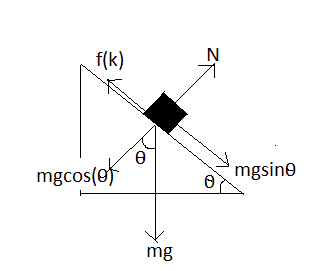
A block has been placed on an inclined plane. The slope angle $\theta $ of the plane is such that the block slides down the plane at a constant speed. The coefficient of kinetic friction is equal to
(A) \[\sin \theta \]
(B) \[\cos \theta \]
(C) \[\sec \theta \]
(D) $\tan \theta $
Answer
218.7k+ views
Hint: We find all the forces acting on the block and add them based on their direction to find the coefficient of friction. Here, the block is moving in a straight path, so, distance and displacement are the same and hence, speed and velocity will also be the same. The acceleration will be zero because velocity is constant, due to which the force acting on the body due to acceleration is zero. To solve this problem, we find the forces acting on the block and add them and equate them to zero.
Formula used:
Kinetic Friction force ${f_k} = \mu {F_N}$
Here, Kinetic Friction force is represented by ${f_k}$
Coefficient of kinetic friction is represented by $\mu $
Normal force is represented by ${F_N}$
Complete step by step solution:
Free body diagram of the block

From the free body diagram, the normal force is equal to ${F_N} = mgcos\theta $
Friction force action between the block and the surface is equal to
${f_K} = \mu {F_N} = \mu mgcos\theta $
Adding all the forces along the plane of inclination
$mg\sin \theta - \mu mgcos\theta = ma$
Since the velocity is constant, acceleration is zero, and the force applied due to the acceleration is also zero.
Solving the equation, we get
$ mg\sin \theta - \mu mgcos\theta = ma $
$ mg\sin \theta - \mu mgcos\theta = 0 $
$ \Rightarrow \mu = \dfrac{{mg\sin \theta }}{{mgcos\theta }} $
$ \Rightarrow \mu = \tan \theta $
Hence the coefficient of friction is equal to \[\mu = \tan \theta \] for which the block moves at a constant speed.
Option (D) \[\mu = \tan \theta \] is the correct answer.
Note: The angle of inclination at which the block just starts to move with a constant speed or acceleration along an inclined surface is called the Angle of Repose. It can also be defined as the maximum angle of inclination at which the block remains at rest. The angle of inclination is equal to the angle made by the weight of the body with its horizontal component.
Formula used:
Kinetic Friction force ${f_k} = \mu {F_N}$
Here, Kinetic Friction force is represented by ${f_k}$
Coefficient of kinetic friction is represented by $\mu $
Normal force is represented by ${F_N}$
Complete step by step solution:
Free body diagram of the block

From the free body diagram, the normal force is equal to ${F_N} = mgcos\theta $
Friction force action between the block and the surface is equal to
${f_K} = \mu {F_N} = \mu mgcos\theta $
Adding all the forces along the plane of inclination
$mg\sin \theta - \mu mgcos\theta = ma$
Since the velocity is constant, acceleration is zero, and the force applied due to the acceleration is also zero.
Solving the equation, we get
$ mg\sin \theta - \mu mgcos\theta = ma $
$ mg\sin \theta - \mu mgcos\theta = 0 $
$ \Rightarrow \mu = \dfrac{{mg\sin \theta }}{{mgcos\theta }} $
$ \Rightarrow \mu = \tan \theta $
Hence the coefficient of friction is equal to \[\mu = \tan \theta \] for which the block moves at a constant speed.
Option (D) \[\mu = \tan \theta \] is the correct answer.
Note: The angle of inclination at which the block just starts to move with a constant speed or acceleration along an inclined surface is called the Angle of Repose. It can also be defined as the maximum angle of inclination at which the block remains at rest. The angle of inclination is equal to the angle made by the weight of the body with its horizontal component.
Recently Updated Pages
Two discs which are rotating about their respective class 11 physics JEE_Main

A ladder rests against a frictionless vertical wall class 11 physics JEE_Main

Two simple pendulums of lengths 1 m and 16 m respectively class 11 physics JEE_Main

The slopes of isothermal and adiabatic curves are related class 11 physics JEE_Main

A trolly falling freely on an inclined plane as shown class 11 physics JEE_Main

The masses M1 and M2M2 M1 are released from rest Using class 11 physics JEE_Main

Trending doubts
JEE Main 2026: Application Form Open, Exam Dates, Syllabus, Eligibility & Question Papers

Derivation of Equation of Trajectory Explained for Students

Hybridisation in Chemistry – Concept, Types & Applications

Understanding the Angle of Deviation in a Prism

Understanding Collisions: Types and Examples for Students

Understanding Atomic Structure for Beginners

Other Pages
JEE Advanced Marks vs Ranks 2025: Understanding Category-wise Qualifying Marks and Previous Year Cut-offs

Units And Measurements Class 11 Physics Chapter 1 CBSE Notes - 2025-26

NCERT Solutions For Class 11 Physics Chapter 8 Mechanical Properties Of Solids

Motion in a Straight Line Class 11 Physics Chapter 2 CBSE Notes - 2025-26

NCERT Solutions for Class 11 Physics Chapter 7 Gravitation 2025-26

How to Convert a Galvanometer into an Ammeter or Voltmeter




